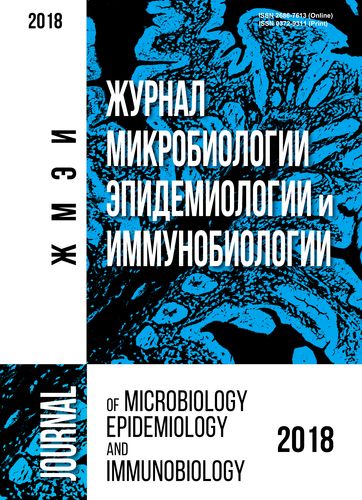МЕТАБОЛИЧЕСКАЯ АКТИВНОСТЬ ВЫСОКОАНТАГОНИСТИЧЕСКИХ ШТАММОВ ЛАКТОБАЦИЛЛ ЗДОРОВОГО ЧЕЛОВЕКА
- Авторы: Червтец В.М.1, Червинец Ю.В.1, Беляева Е.А.1, Петрова О.А.1, Гатт Е.Б.1
-
Учреждения:
- Тверской государственный медицинский университет
- Выпуск: Том 95, № 4 (2018)
- Страницы: 11-17
- Раздел: СИМБИОТИЧЕСКИЕ ВЗАИМОДЕЙСТВИЯ НОРМОФЛОРЫ И ХОЗЯИНА
- URL: https://microbiol.crie.ru/jour/article/view/280
- DOI: https://doi.org/10.36233/0372-9311-2018-4-11-17
- ID: 280
Цитировать
Полный текст
Аннотация
Ключевые слова
Об авторах
В. М. Червтец
Тверской государственный медицинский университет
Автор, ответственный за переписку.
Email: noemail@neicon.ru
Россия
Ю. В. Червинец
Тверской государственный медицинский университет
Email: noemail@neicon.ru
Россия
Е. А. Беляева
Тверской государственный медицинский университет
Email: noemail@neicon.ru
Россия
О. А. Петрова
Тверской государственный медицинский университет
Email: noemail@neicon.ru
Россия
Е. Б. Гатт
Тверской государственный медицинский университет
Email: noemail@neicon.ru
Россия
Список литературы
- Агапова О.В., Бондаренко В.М., Поликарпов Н.А. Ферменты патогенности клинических штаммов Klebsiella pneumoniae. Журн. микробиол. 1999, 2: 5-8.
- Гаврилова О.А., Червинец Ю.В. Содержимое зубодесневого желобка у дошкольников: физические и микробиологические характеристики. Стоматология детского возраста и профилактика. 2009, 2: 66-68.
- ГОСТ 33045-2014. Метод капиллярного электрофореза с использованием системы капиллярного электрофореза «Капель». ПНД Ф 14.1:2:4.167-2000. М., 2000.
- Червинец Ю.В. и др. Генетическая идентификация антагонистически активных штаммов лактобацилл, выделенных из полости рта здоровых людей. Клиническая лабораторная диагностика. 2010, 11: 43-46.
- Червинец Ю.В. и др. Индигенные лактобациллы полости рта человека - кандидаты в пробиотические штаммы. Курский научно-практический вестник «Человек и здоровье». 2012, 1: 131-137.
- Червинец В.М. и др. Пробиотический и адаптационный потенциал лактобацилл, перспективных для конструирования эффективных пробиотических препаратов. Экспериментальная и клиническая гастроэнтерология. 2016, 126 (2): 108.
- Шендеров Б.А. Роль эндогенных и микробных газовых молекул в физиологии патофизиологии сердечно-сосудистой системы. Вестник восстановительной медицины. 2015, 5: 58-65.
- Althaus M., Clauss W.G. Gasotransmitters: novel regulators of ion channels and transporters. Front Physiol. 2013, 4: 27. doi: 10.3389/fphys.2013.00027.
- Casey P.G., Casey G.D., Gardiner G.E. et al. Isolation and characterization of anti-Salmonella lactic acid bacteria from the porcine gastrointestinal tract. Lett. Appl. Microbiol. 2004, 39: 431-438.
- Lebeer S., Vanderleyden J., De Keersmaeker S.C.J. Genes and molecules of lactobacilli supporting probioticaction. Microbiol Mol. Biol. Rev. 2008. 72: 728-764.
- Mikelsaar M., Sepp E., Stsepetova J. et al. Biodiversity of Intestinal Lactic Acid Bacteria in the Healthy Population. Advances in Microbiology, Infectious Diseases and Public Health. 2016, 4: 1-64. doi: 10.1007/5584_2016_3.
- MU 2.3.2.2789-10 Guidelines for the sanitary-epidemiological assessment of the safety and functional potential of probiotic microorganisms used for food production. Food Raw Materials and Food Products. 2010, Moscow (in Russia).
- Shenderov B.A. Probiotics and Functional Foods, 2011. In Food Engineering, Encyclopedia of Life Support Systems (EOLSS). Developed under the Auspices of the uNesCo, Eolss Publishers, Oxford, UK. (http:www. eolss.net).
- Sasithorn Sirilun, Chaiyavat Chaiyasut, Duangporn Kantachote, Plearnpis Luxananil Characterisation of non-human origin probiotic Lactobacillus plantarum with cholesterollowering property. African J. Microbiology Research. 2010, 4 (10): 994-1000.
- Tinajero-Trejo M., Jesse H.E., Poole R.K. Gasotransmitters, poisons, and antimicrobials: it’s a gas, gas, gas! F1000Prime Report. 2013, 5: 28. doi: 10.12703/P5-28.
Дополнительные файлы






